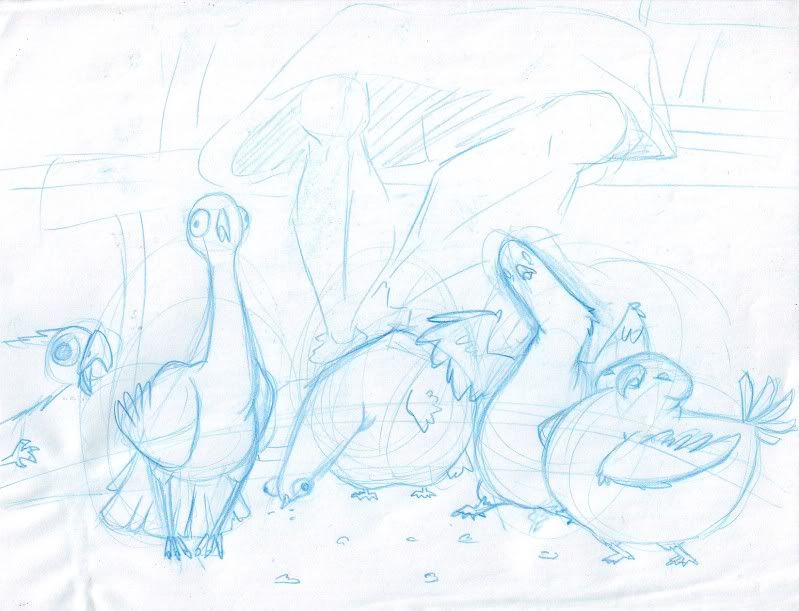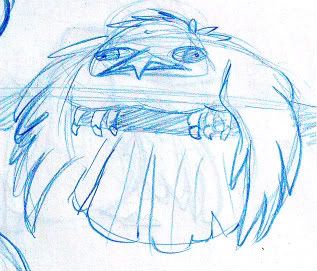I began thinking about the styles of animation, and how they function as a whole - as a drawing, as a movement, as a theme, and as depth.
In order to get into the depth I'd like to, I'm going to break these up into separate posts, so you can get as much information as I want to cram down your throats without being a long-winded airbag. Or at least, more longwinded than usual.
Drawing is what most people think about, when they think of animation. It's Flash, it's traditional, it's cartoony, it's realistic. A style goes through the entirety of a single visual, within animation. It's not something that is restricted to characters - it goes through props, layouts, and special effects.
The first thing I thought of was Disney's Lilo and Stitch. It was one of their first movies to make a push for a distinctive style, rather than their usual quasi-realism. The characters are based from Chris Sander's designs, making every drawn aspect of this movie very round, and soft, with all sharp edges replaced with a more rounded feel.
Have a look at the characters here - whether human, or alien, all sharp or jagged areas have been replaced by a smooth curve - even the most pointed areas have been rounded off.



In particular, look at Plekley's antenna and shoulder pads, the alien on the far left with the horn, and Lilo's hair and grass skirt. All of those things, you would think would end in sharper points - wet hair is very jagged, as are grass skirts, but both these things have been thoroughly rounded out. The same thing happens in the tassles off Plekley's shoulderpads, but unfortunately, I'm not working with high-quality images.
You'll find that the same rounding off, of things that are normally very sharp or angular, are smoothed out when looking at props, such as Lilo's doll, Scrump, or any of the alien guns.


Even in special effects, you can see the rounding, which is the part I think is really neat. One of the things about special effects is that it pays to be not noticed. If they don't stand out, they've been done right. In this case, they have most definitely been done right.



Have a look at the water, and how it feels more like whipped cream than crashing surf. The feel of the gunfire really lends to the idea that they are plasma weapons, rather than the gunpowder we're so used to. And even when a WHOLE SPACESHIP is exploding, it's still soft, and rounded.
The interesting thing, to me, is the layout design of Lilo and Stitch. The entirety of the movie is soft, rounded, and gooey. If layouts fit that style, too, the entire movie would feel like being in a marshmallow world. So how did they keep the style, and have their realism too? By breaking the style.


By doing things in watercolour, they not only had a simple way to make the action stand out from the background, but they were able to do an interesting combination of ridgidity and softness. They could have their hard lines, to make buildings seem more feasible, but have a soft shading style that would still make it seem less harsh than the average layout of something like Lion King, where everything is equally saturated and hard.

It's easy to see how things in Lilo and Stitch fall together in a style. Even easier is a lot of television work, such as Nickelodeon's Fairly Odd Parents.
The characters - straight lines, ridgid, and when there's a curve, it's a very simple one - no S-curves in sight! Simplicity is the name of the game here, and you can see it repeated everywhere. The backgrounds are minimalist, as to have the most focus on the characters. They even push your focus by desaturating the background, making Timmy and his dinosaur the brightest, and most interesting things.

And here we have another grand example, involving layouts, props, and special effects.

The props are flat and basic, just like the characters. Check out the rolling pin of the lady on the far right, or the tire in the bottom right. Simple, iconic shapes.
Same goes for the special effects. Fire, as an icon, is a jagged shape, so that's what they did. The water spewing from the ground is a column, with a wibbly-wobbly blob on the top. Is that what water actually looks like? Not a chance. Do you recognise it? You bet. Even the smoke coming out of the sewer, or off the plane are just basic curves going up.
And again, the layouts are simple - the houses are literally just lines on the background of the sky. And once more, everything is very desaturated, except for the sections they want you to look - the characters, the fire, the water.
The entire style of this show is unified, with no excpetions to the rule. Neat-o!
Next week, I'll be scrambling together a post about Style as a movement. Stay tunes, kiddies!






























